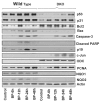Inactivation of the quinone oxidoreductases NQO1 and NQO2 strongly elevates the incidence and multiplicity of chemically induced skin tumors
- PMID: 20103645
- PMCID: PMC2943744
- DOI: 10.1158/0008-5472.CAN-09-2938
Inactivation of the quinone oxidoreductases NQO1 and NQO2 strongly elevates the incidence and multiplicity of chemically induced skin tumors
Retraction in
-
Retraction: Inactivation of the Quinone Oxidoreductases NQO1 and NQO2 Strongly Elevates the Incidence and Multiplicity of Chemically Induced Skin Tumors.Cancer Res. 2018 Nov 1;78(21):6345. doi: 10.1158/0008-5472.CAN-18-2453. Cancer Res. 2018. PMID: 30385611 Free PMC article. No abstract available.
Abstract
The cytosolic quinone oxidoreductases NQO1 and NQO2 protect cells against oxidative stress by detoxifying quinones and preventing redox cycling. In this study, we used double knockout (DKO) mice deficient for NQO1 and NQO2 to investigate the role of these antioxidative enzymes in a two-stage model of inflammatory skin carcinogenesis. In this model, tumors are caused by exposure to topical carcinogen dimethylbenz(a)anthracene or benzo(a)pyrene (BP) followed by twice weekly application of proinflammatory phorbol 12-myristate 13-acetate. On this classic chemical carcinogenesis protocol, DKO mice showed a significantly higher skin tumor frequency and multiplicity compared with control wild-type or single knockout mice. Analysis of skin from wild-type and DKO mice exposed to BP for 6, 12, or 24 hours revealed a relative delay in the activation of p53, p63, p19ARF, and apoptosis in DKO mice, consistent with a negative modifier role for NQO1/NQO2 in carcinogenesis. Our findings offer genetic evidence of the significance of quinone oxidoreductases NQO1 and NQO2 in limiting chemical skin carcinogenesis.
Figures






Similar articles
-
Deficiency of NRH:quinone oxidoreductase 2 increases susceptibility to 7,12-dimethylbenz(a)anthracene and benzo(a)pyrene-induced skin carcinogenesis.Cancer Res. 2004 Sep 1;64(17):5925-8. doi: 10.1158/0008-5472.CAN-04-0763. Cancer Res. 2004. PMID: 15342368
-
Lower induction of p53 and decreased apoptosis in NQO1-null mice lead to increased sensitivity to chemical-induced skin carcinogenesis.Cancer Res. 2005 Mar 15;65(6):2054-8. doi: 10.1158/0008-5472.CAN-04-3157. Cancer Res. 2005. PMID: 15781611
-
NAD(P)H:quinone oxidoreductase 1 deficiency increases susceptibility to benzo(a)pyrene-induced mouse skin carcinogenesis.Cancer Res. 2000 Nov 1;60(21):5913-5. Cancer Res. 2000. PMID: 11085502
-
Quinone oxidoreductases in protection against myelogenous hyperplasia and benzene toxicity.Chem Biol Interact. 2005 May 30;153-154:147-57. doi: 10.1016/j.cbi.2005.03.019. Epub 2005 Apr 7. Chem Biol Interact. 2005. PMID: 15935811 Review.
-
NRH:quinone oxidoreductase2 (NQO2).Chem Biol Interact. 2000 Dec 1;129(1-2):99-112. doi: 10.1016/s0009-2797(00)00200-3. Chem Biol Interact. 2000. PMID: 11154737 Review.
Cited by
-
The antidote effect of quinone oxidoreductase 2 inhibitor against paraquat-induced toxicity in vitro and in vivo.Br J Pharmacol. 2013 Jan;168(1):46-59. doi: 10.1111/j.1476-5381.2012.01870.x. Br J Pharmacol. 2013. PMID: 22289031 Free PMC article.
-
Genetic evidence for NAD(P)H:quinone oxidoreductase 1-catalyzed quinone reduction on passage through the mouse pulmonary circulation.Am J Physiol Lung Cell Mol Physiol. 2011 May;300(5):L773-80. doi: 10.1152/ajplung.00394.2010. Epub 2011 Feb 4. Am J Physiol Lung Cell Mol Physiol. 2011. PMID: 21296895 Free PMC article.
-
Cytochrome P450 1b1 in polycyclic aromatic hydrocarbon (PAH)-induced skin carcinogenesis: Tumorigenicity of individual PAHs and coal-tar extract, DNA adduction and expression of select genes in the Cyp1b1 knockout mouse.Toxicol Appl Pharmacol. 2015 Sep 1;287(2):149-160. doi: 10.1016/j.taap.2015.05.019. Epub 2015 Jun 3. Toxicol Appl Pharmacol. 2015. PMID: 26049101 Free PMC article.
-
Melatonin: A Cutaneous Perspective on its Production, Metabolism, and Functions.J Invest Dermatol. 2018 Mar;138(3):490-499. doi: 10.1016/j.jid.2017.10.025. Epub 2018 Feb 7. J Invest Dermatol. 2018. PMID: 29428440 Free PMC article. Review.
-
NQO1 suppresses NF-κB-p300 interaction to regulate inflammatory mediators associated with prostate tumorigenesis.Cancer Res. 2014 Oct 1;74(19):5644-55. doi: 10.1158/0008-5472.CAN-14-0562. Epub 2014 Aug 14. Cancer Res. 2014. PMID: 25125658 Free PMC article.
References
-
- International Agency for Research on Cancer (IARC) IARC Monographs on the Evaluation of Carcinogenic Risks of Chemicals to Humans-Polynuclear Aromatic Compounds. 33–91. Vol. 32. Lyon: International Agency for Research on Cancer Scientific Pub; 1983. pp. 211–24.
-
- Pugalendhi P, Manoharan S, Panjamurthy K, Balakrishnan S, Nirmal MR. Antigenotoxic effect of genistein against 7,12-dimethylbenz[a]anthracene induced genotoxicity in bone marrow cells of female Wistar rats. Pharmacol Rep. 2009;61:296–303. - PubMed
-
- Prince M, Campbell CT, Robertson TA, Wells AJ, Kleiner HE. Naturally occurring coumarins inhibit 7,12-dimethylbenz[a]anthracene DNA adduct formation in mouse mammary gland. Carcinogenesis. 2006;27:1204–13. - PubMed
-
- Housman TS, Feldman SR, Williford PM, et al. Skin cancer is among the most costly of all cancers to treat for the medicare population. J Am Acad Dermatol. 2003;48:425–9. - PubMed
-
- Ross D. Quinone reductases multitasking in the metabolic world. Drug Metab Rev. 2004;36:639–54. - PubMed
Publication types
MeSH terms
Substances
Grants and funding
LinkOut - more resources
Full Text Sources
Medical
Molecular Biology Databases
Research Materials
Miscellaneous

